This Chinese stir fry sauce is the only one you’ll ever need! I like making it at home because it’s simple to customize the balance of flavors to your liking.
Use my favorite Chinese stir fry sauce to quickly make your favorite stir fry or even saucy Asian noodles. It’s very versatile. It adds so much flavor and will take your dish to a whole new level!
It’s make-ahead friendly, so make a big batch and use it for any quick and delicious weeknight meals. It will last for weeks!
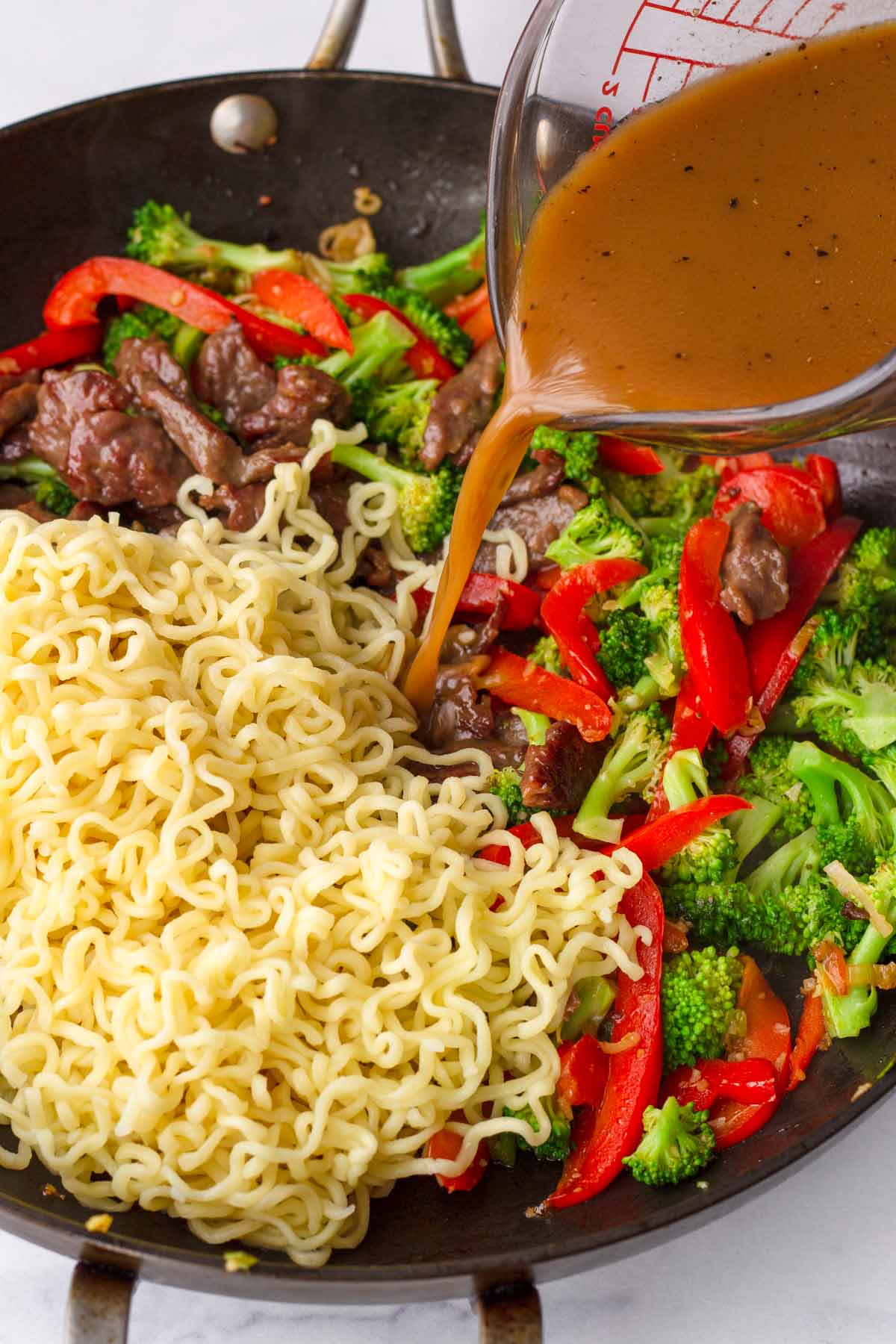
How many times have you been overwhelmed by an excessively salty and oversaturated stir fry? Yup, same here. By making your own at home, you can make sure that never happens. It’s the same reason I like to make teriyaki sauce, which is perfect for this Chicken Teriyaki Stir Fry recipe.
The key to the perfect Chinese stir fry sauce is achieving the perfect balance of savory, sweet, and umami flavors. It’s got richness from oyster sauce, depth from soy sauce and cooking wine, sweetness from sugar, and nuttiness from sesame oil. A simple cornstarch slurry thickens it perfectly.
And I LOVE using it to make my Beef and Broccoli Ramen Stir Fry!
Chinese dishes have so many complex flavor profiles, but this basic sauce is one that I use in pretty much every stir fry and it never disappoints. I always make it weeks in advance – it keeps pretty well in the fridge!
This recipe is versatile and all-purpose. I usually use whatever ingredients you have on hand, toss with aromatics and the homemade sauce in a hot wok, serve with coconut jasmine rice, ta-da…dinner is ready!
Why you’ll LOVE this Chinese stir fry sauce recipe:
- Ready in under 5 minutes: This is a no-cook recipe. All you need to do is whisk all the ingredients, and done!
- Make-ahead friendly, so make a big batch and you’ll be only one step away from a delicious weeknight meal. It will last weeks in the fridge.
- Very versatile: Use it on any protein, favorite veggies, or even noodles!
- Customizable: While I designed this recipe to not be overly salty, everybody has different preferences. Just give it a taste and adjust the flavor profile to taste.
Jump to:
A Versatile, All-Purpose Stir Fry Sauce
Chinese stir fry sauce is incredibly versatile and can be used with a variety of ingredients. Use it with any protein, any veggies, and even noodles! It will add so much incredible flavor.
I’ve used it to make my Shrimp Lo Mein because I had extra leftover sauce, and it was SO GOOD! Such a big time saver.
This is great for busy weeknights and meal prep as well. We usually slice up all the veggies and protein in advance. You’ll be amazed at how quickly it can all come together once you have everything prepped! 10 minutes at most. No kidding.
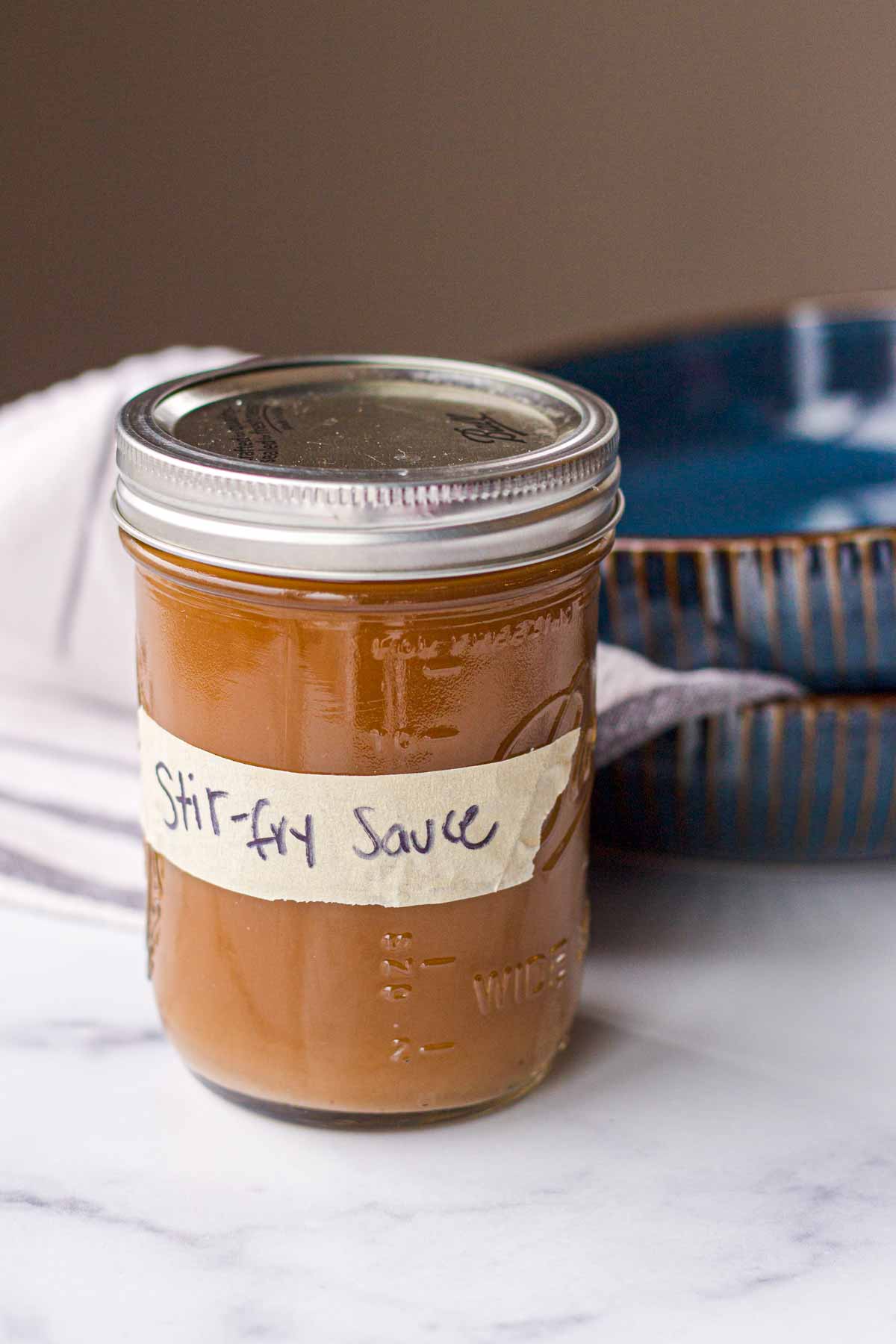
How to Make a Basic Stir Fry
Here’s a basic stir fry cooking method that you can use with any ingredients:
- Cook your protein and vegetables of choice in a hot wok or skillet.
- Add aromatics (garlic, ginger, and sliced scallions) until fragrant.
- Add the sauce to taste and toss everything to combine. And that’s it!
Here are some of my favorite protein + veggie combinations for some inspiration:
- Chicken or beef + broccoli and sliced onions
- Thinly sliced beef + sliced mushrooms of your choice and bok choy
- Shrimp + snow, water chestnuts, sliced carrots, and bamboo shoots
- Chicken + asparagus spears, sliced carrots, water chestnuts, and green onions
- Cubed firm tofu + sliced zucchini, snow peas, bell peppers, and baby corn
- Beef + rice noodles, snow peas, carrots
- Try my Ramen Stir Fry recipe!
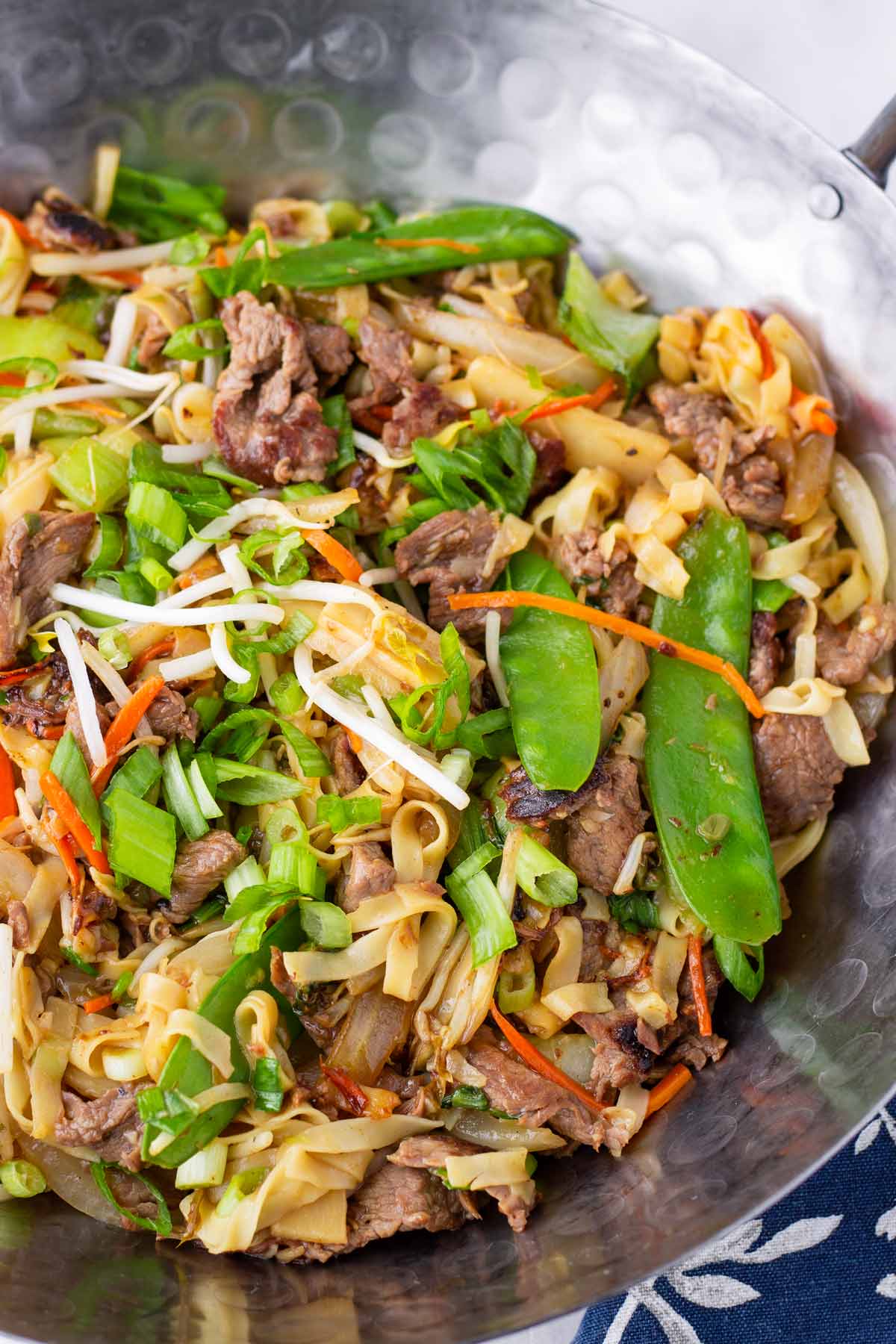
Chinese Shaoxing Cooking Wine
You’ll notice that this recipe calls for Chinese Shaoxing cooking wine. It’s a staple ingredient in Chinese cuisine, as it adds depth and flavor to any dish.
Shaoxing wine is a rice wine that gets its name from the city of Shaoxing in Zhejiang province, where it is produced. It’s got a dark amber or brown color. As for flavor, it’s got complex and rich flavors (vinegar-y, spicy, strong) with a touch of sweetness.
You can find it in most Asian grocery stores near the oil and vinegar section, or you may also purchase it online.
Substitution: If you can’t find Chinese cooking wine, use dry sherry instead. If you prefer not to use alcohol, you may substitute with broth.
Ingredient Notes
Here are a few helpful notes on the ingredients I used to make Chinese stir fry sauce.
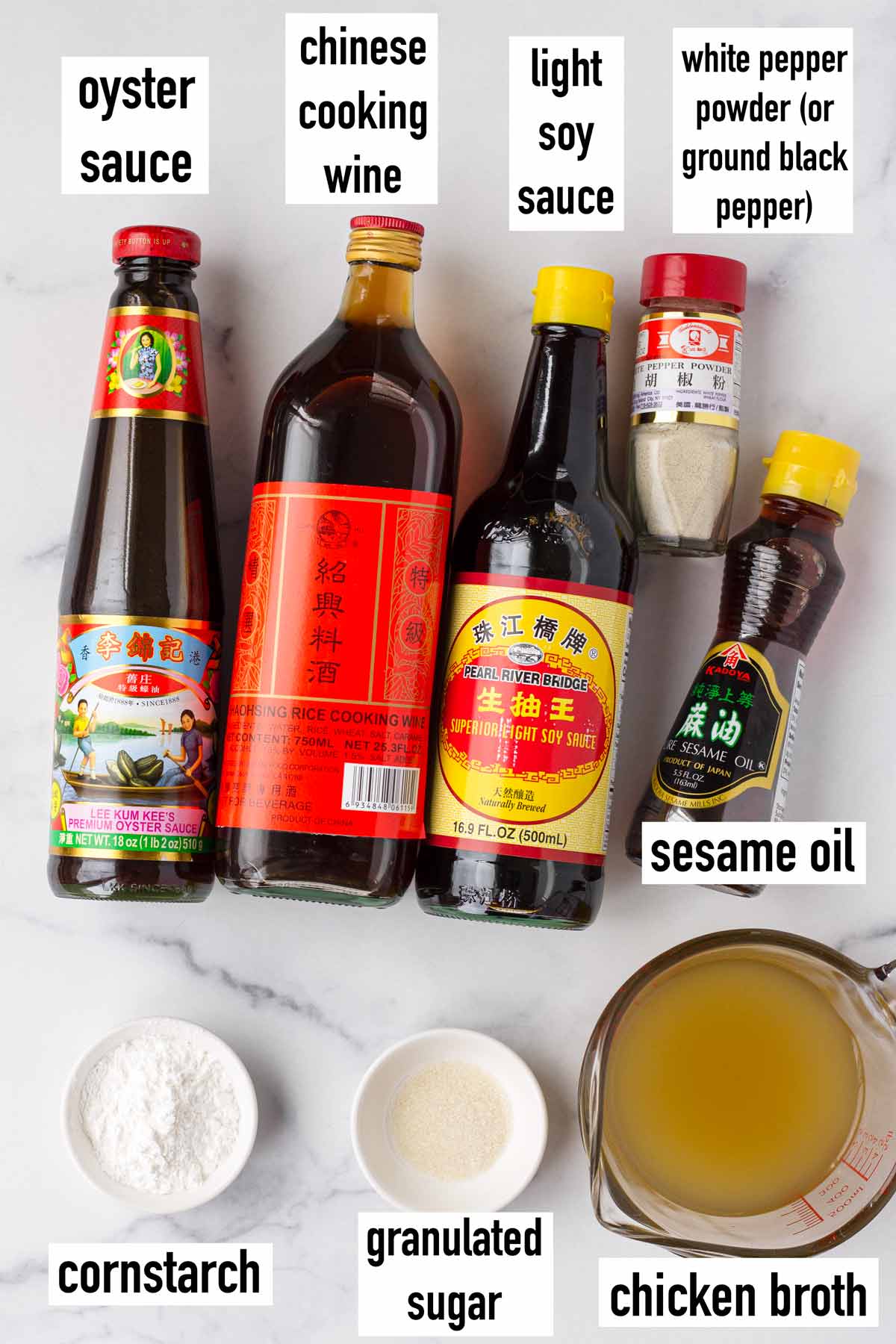
- Chinese Shaoxing wine (or dry sherry): Adds complexity and depth.
- Light soy sauce: Provides that salty umami kick. Make sure to use “light” soy sauce so it’s not too overly salty.
- Oyster sauce: Imparts a rich, savory taste and adds depth and a touch of sweetness. I use “premium oyster sauce” from Lee Kum Kee’s brand.
- Cornstarch: Acts as a thickening agent, giving the sauce a glossy texture.
- Chicken or vegetable broth: It helps to dilute the savory flavors of the soy sauce and oyster sauce. While some recipes call for water, I think broth works better because it adds extra flavor.
- Granulated sugar: Balances the saltiness and enhances overall flavors. Brown sugar is fine too, but graduated is more traditionally used.
- Sesame oil: Adds that distinct nutty aroma and adds a final touch of authenticity. I’d recommend using Kadoya’s brand.
- White pepper powder or ground black pepper
Step-by-Step Tutorial
It takes less than 5 minutes to whisk this Chinese stir fry sauce! It starts with a cornstarch slurry, which will help thicken it just right. After that, it’s all about mixing everything together. Here’s how to do it!
Step 1 | Make the cornstarch slurry
In a medium mason jar, whisk the cornstarch with chicken broth to create a slurry. Stir until fully dissolved.
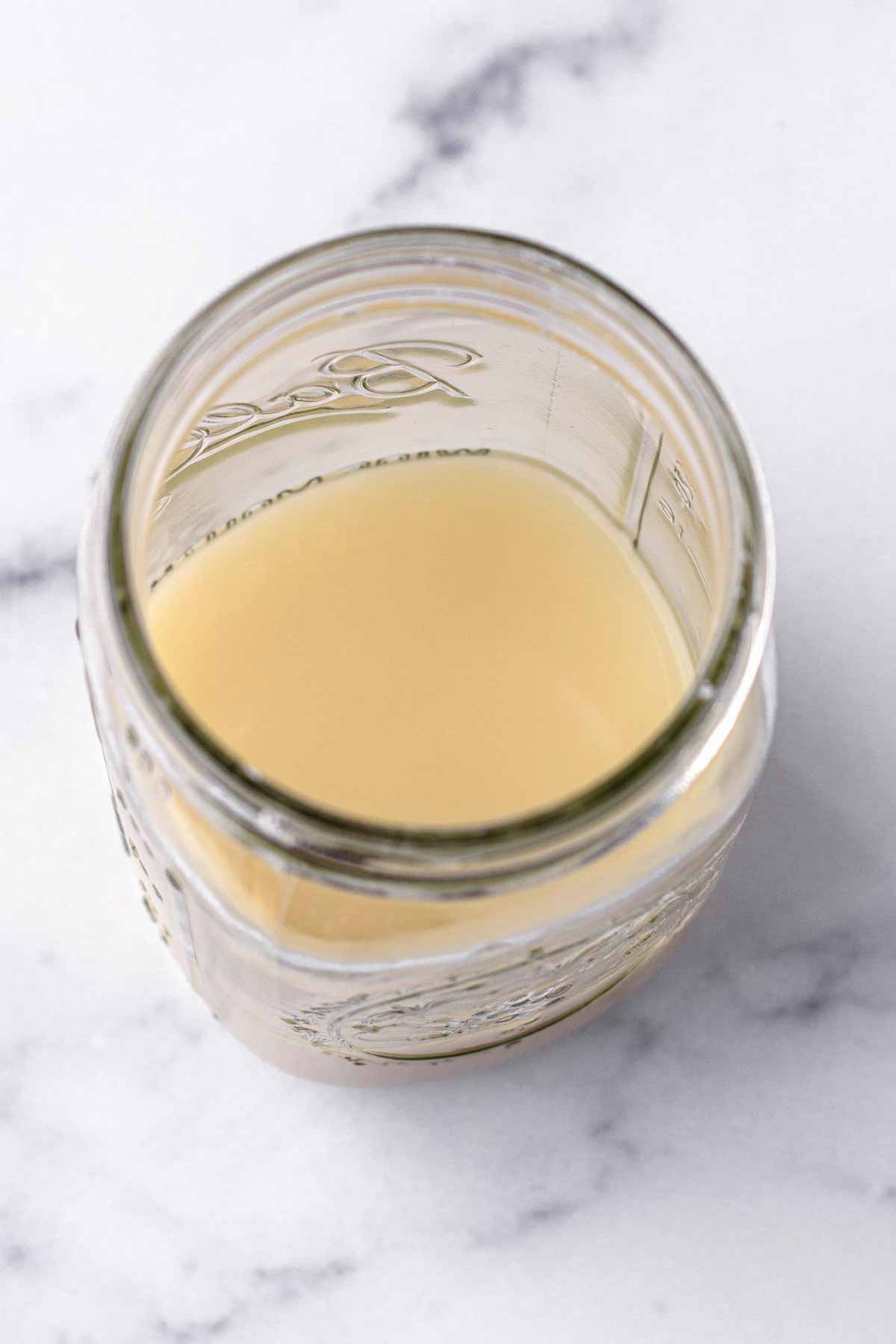
Step 2 | Add the rest of the ingredients
Then, add the remaining ingredients, including the Chinese cooking wine, soy sauce, oyster sauce, sugar, sesame oil, and ground pepper.
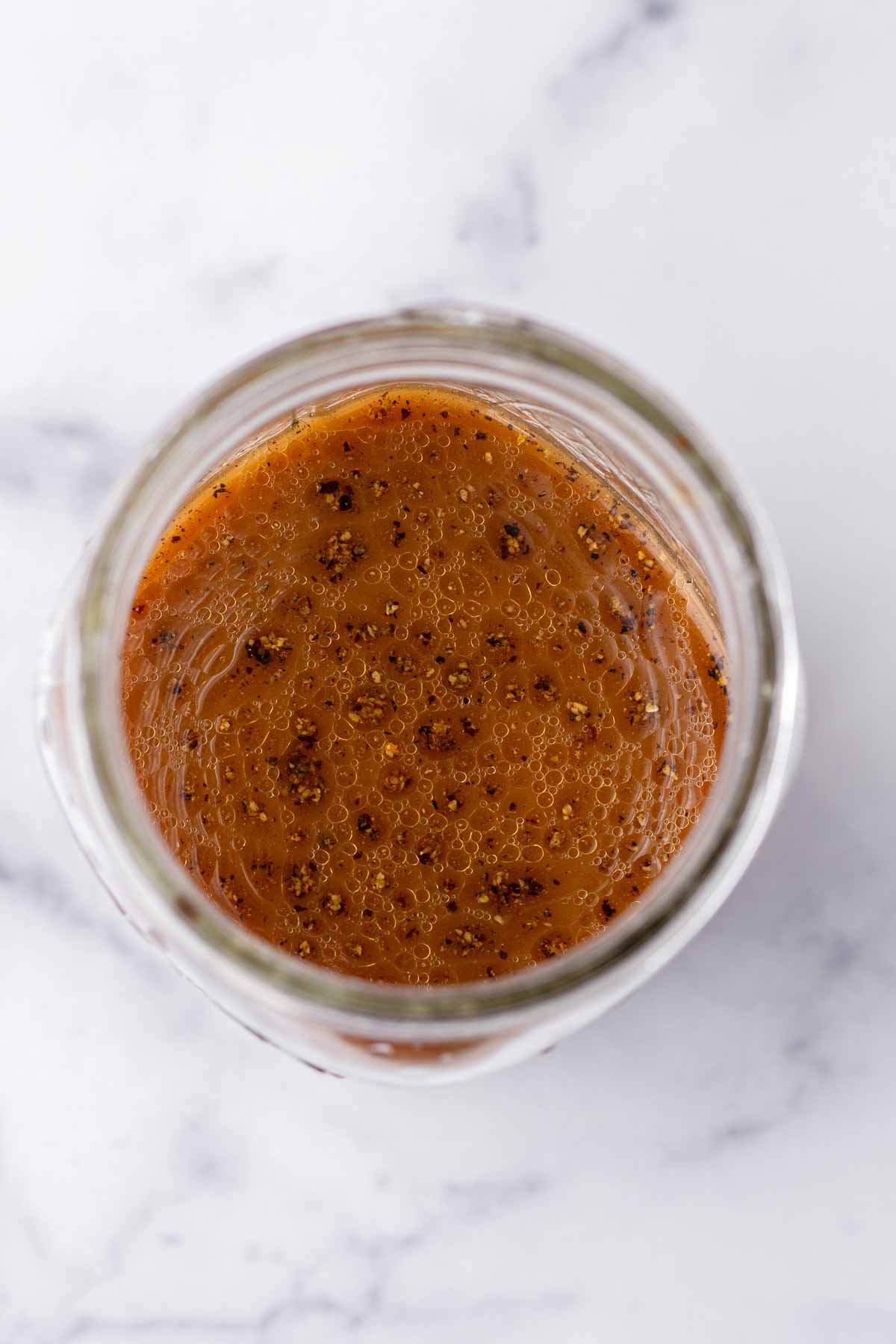
Step 3 | Shake to combine
Seal the jar and shake to combine vigorously. You can also use a whisk if you don’t have a mason jar. At this point, give it a taste and adjust flavors as needed.
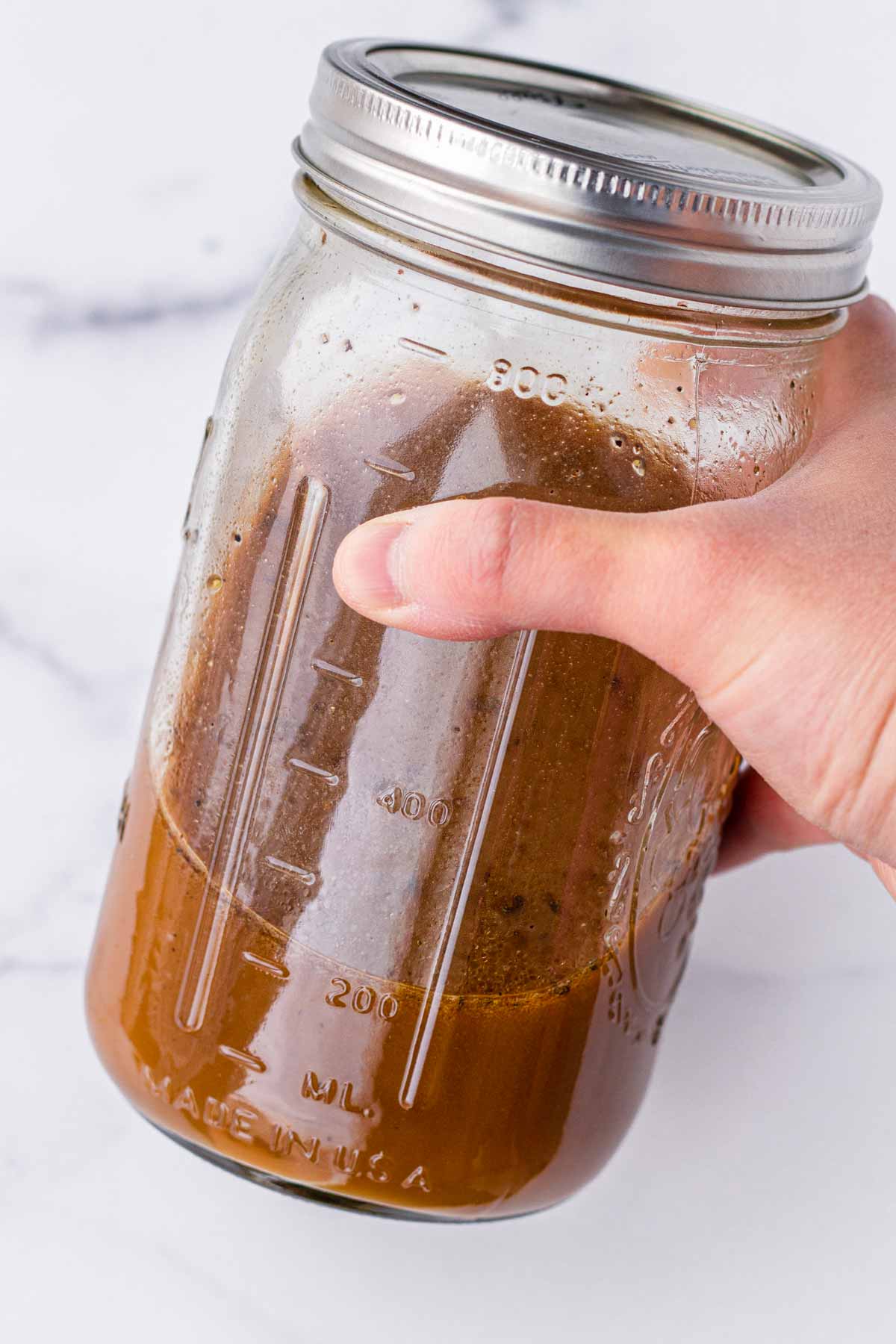
How to Adjust Flavors
I’ve lost track of how many times I have hated stir fries served at restaurants because of how salty they were. The great thing about this Chinese stir fry sauce recipe is that you can adjust flavors to your liking. Here are a few guidelines:
- Saltier: A little bit more soy sauce, but don’t overdo it.
- Too salty: Add some water.
- More flavor: Add more oyster sauce, but keep in mind this will also add some saltiness. You may also add more cooking wine or dry sherry.
- More balanced: Add an extra touch of sugar.
Make Ahead and Storage
The stir fry sauce will last a few weeks in the fridge. I’ve kept it for about 2 weeks in the past. Store in a sealed container.
When you need to use it, give it a quick stir to dissolve any cornstarch that may be sitting at the bottom. I also noticed that, when stored, the flavors and saltiness develop even more, so add 2 to 3 tablespoons of water if needed to balance the flavors when cooking.
Freezing? I don’t see why not. The best way is to freeze in pre-portioned containers so you can use just the amount you need. I’d recommend these Souper Cubes. There’s no need to thaw – just add it straight to the hot skillet or wok.
Pairing and Serving Ideas
I like to serve my stir fries with basic steamed rice, which I make in my favorite Zojirushi rice cooker. If you want to step up your rice game, try my Coconut Jasmine Rice, Chinese Sausage Fried Rice, or Curry Fried Rice.
You can also use the sauce to make an easy beef and broccoli ramen stir fry!
Other Chinese recipes I love: Chinese Chicken Corn Soup, Asian Chicken Lettuce Wraps, and Honey Sesame Chicken. Definitely give these a try!
Recipe FAQs
I would not recommend it. Because this sauce has corn starch, it will thicken, which will make the rice very wet and saucy.
I’ve tested this recipe several times so it doesn’t taste too salty because I, too, hate it when it’s overly salty. However, you can always adjust the flavors to taste.
No. In Chinese cooking, the aromatics (garlic, ginger, and scallions) are added to the hot wok, which brings out fragrant tones.
Make a cornstarch slurry by mixing and diluting cornstarch with broth.
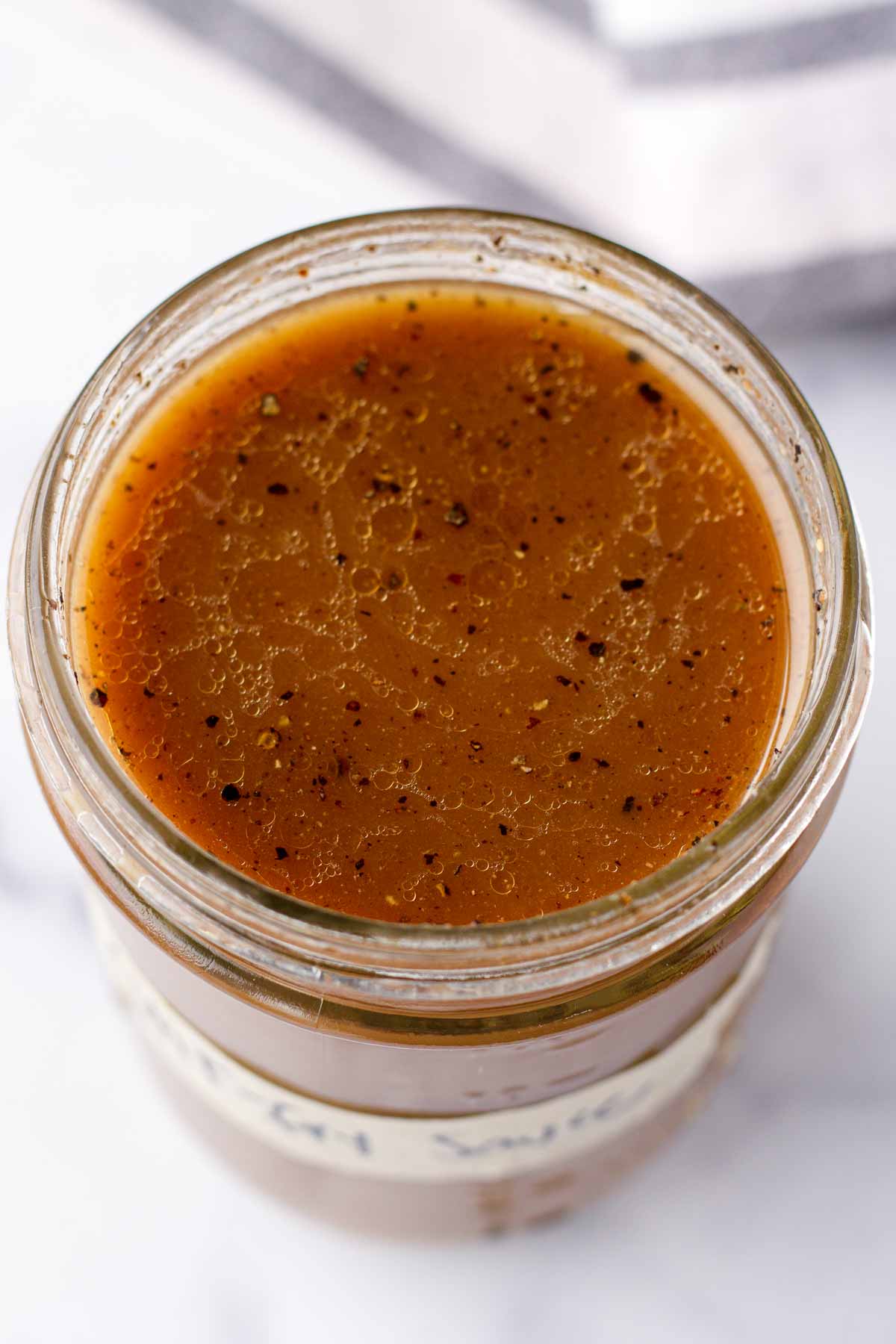
Tips for Success
- Dissolve the cornstarch in the broth first. For some reason, I find it easier to mix cornstarch with broth or water first. It dissolved better.
- Once you’ve made the sauce, customize the flavor profile to your liking. For more saltiness, add more soy sauce or oyster sauce. If it’s too salty, add some water or broth.
- Shaoxing Chinese cooking wine substitution: Dry sherry is a good substitute ingredient. It won’t be the same, but works well. If you prefer not to use wine, substitute with more broth.
- Make ahead and storage: Refrigerate in a sealed container for about 2 weeks. Give it a good stir before using, and add a few extra tablespoons of water as needed because the savory flavors can further develop when stored.
I’d love to hear from you! If you loved my recipe, please consider leaving a 5-star rating and a comment down below. Sign up for my newsletter and follow along on Instagram, Facebook, or Pinterest
5-Minute Chinese Stir-Fry Sauce
Equipment
Ingredients
- 1 cup chicken broth - or vegetable broth
- 2 tablespoons cornstarch
- 2 tablespoons Chinese Shaoxing cooking wine - or dry sherry
- ¼ cup LIGHT soy sauce
- 4 tablespoons oyster sauce - I use Lee Kum Kee's brand premium oyster sauce
- 1 teaspoon granulated sugar
- 1 teaspoon sesame oil, or to taste - I use Kadoya brand
- Ground black pepper to taste - or white pepper powder
Instructions
- In a mason jar, whisk the cornstarch with chicken broth to create a slurry, until fully dissolved. Make sure the jar is large enough since you'll need to shake to combine.
- Then, add the remaining ingredients. Seal the jar and shake to combine evenly. Give it a taste and adjust the flavor profile to taste (see "How to adjust flavors" in the recipe notes below).
- Use immediately on stir fries, or refrigerate for up to 2 weeks.
Notes
- Make ahead: Store in the refrigerator for 2 to 3 weeks in a sealed container. Before using, stir to dissolve cornstarch that may have accumulated at the bottom. Add a few extra tablespoons of water because the saltiness can further develop when stored.
- Freezing: Freeze food in pre-portioned containers like Souper Cubes. You may then use the exact amount you require without having to defrost it. Simply add it to a hot skillet or wok.
- How to adjust flavors:
- Saltier: A little bit more soy sauce, but don’t overdo it.
- Too salty: Add some water.
- More flavor: Add more oyster sauce, cooking wine, or dry sherry.
- More balanced: Add sugar.
- Chinese cooking wine: Dry sherry.
- Cornstarch: I would not recommend substituting with flour because the sauce will lack that glossy appearance, and the consistency won’t be quite right.
- Vegetarian: Use vegetable broth and vegetarian oyster sauce.
- Gluten-Free: Regular soy sauce isn’t gluten-free. To make it gluten-free, use tamari or gluten-free soy sauce. Also look for gluten-free oyster sauce. Double check the labels.


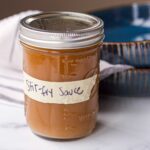


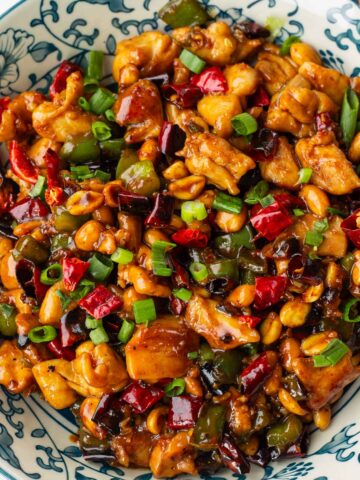
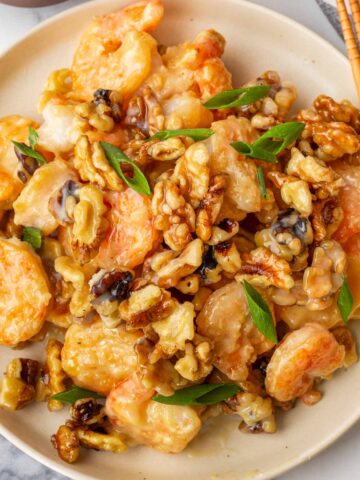

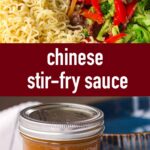
Anna says
BEST stir fry sauce I have ever tried and I’ve tried many. I made it exactly as written and it was perfect, just the right amount of everything. Thank you! I threw out all my other stir fry sauce recipes.
Dee says
I didn’t have all the ingredients (oyster sauce), but it still turned out great! Thanks for this quick and easy recipe.
Tania says
Thanks for your kind words!